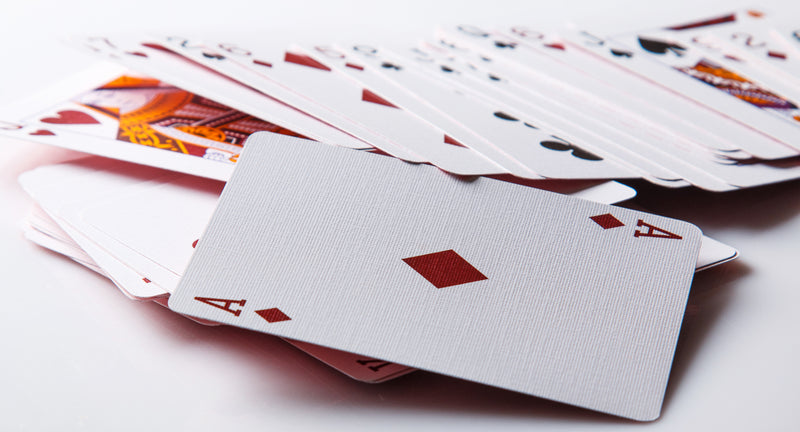
Plastic Playing Cards
Copag USA sells top of the line plastic playing cards. There are many benefits to owning 100% plastic cards over the normal paper cards. The benefits include:
- Significantly more durable
- Not as easy to cheat with
- Can be cleaned
- Don’t bend as easily
- The “feel” to them is unique in itself
- Much easier to shuffle
Plastic cards are mainly used for their durability, this is a big reason that Casinos use them, along with their many other advantages. Another reason why Casinos use plastic cards is due to the difficulty to cheat with them. Many people will try to “markup” the cards, either by using sandpaper or a scratch on the cards to get a small edge during a Poker match. Plastic cards are much harder to markup, making them ideal for casinos, or at home playing with your sneaky friends.
Imagine having your weekly poker night with friends, and you spill your drink all over the cards or accidentally drop the deck in a plate of nachos. Problem right? Not with plastic cards. Just gather the affected cards, and wash them. Refer to this page on how to properly clean your cards. If this were to happen with a paper deck, they would most likely be ruined.
Playing cards are going to get wear and tear, it’s unavoidable. Although, 100% plastic cards have a much higher longevity than paper. Research shows that plastic cards will last up to 50 times longer than a paper deck. Paper cards will bend easily, making plastic cards the better choice for rough shufflers or parents who’s kids might get ahold of the deck.
There are many misconceptions that plastic cards are 100% plastic, this is not the case. Most “plastic cards” only have a thin coat of plastic layered on cardboard. When Copag says plastic, it means the cards are 100% plastic. The feel of these two variations of cards is very different. Right out of the box they will feel the same, but after a few hours of play, the 100% plastic cards will feel brand new, while the plastic-coated cards will become difficult to shuffle and play.

Copag’s plastic cards are very beneficial for beginners, they are much easier to shuffle, and will continue to be easy for the deck’s lifetime. Plastic cards have also been shown to shuffle easier than paper, due to the paper having much more friction, while as the plastic cards will easily slide into place.
Plastic playing cards are overall going to be more costly than paper playing cards. Most paper cards range from $7.99-$3.99 You can get cheaper paper cards but our cards in that price range have what is known as a TRUE Linen B9 Finish. While being cheaper, they will wear out much faster. The cost for a single plastic deck is $8.00-$8.50 for Copag and about $15 for our competitors (although at this price you will get 2 decks).
Overall, 100% plastic playing cards are much more durable, harder to cheat with, have the ability to be cleaned, don’t bend as easily, have a unique “feel” and are much easier to shuffle. The downside is they are a bit more expensive than paper cards, but the lifetime on a deck of plastic cards is much higher than that of a paper deck.
Paper Playing Cards
You may be wondering why someone would ever choose paper cards over plastic. Well, there are many reasons why someone would.
- Much cheaper
- The go-to deck for magic and cardistry
Many people will start out with a paper deck, mainly due to their price. As mentioned above you can get a paper deck as low as $3. This will bring in a lot of people that are just starting out with magic or card games.
If you have ever seen a magician perform they were most likely using a paper deck of cards. There are many reasons why magicians prefer to use paper cards.
- They easily tear, fold, and burn.
- Paper is more forgiving
Many magicians use tactics to wow a crowd that involves tearing, folding, or burning a card. This is much harder to do with plastic cards. With a card that is 100% plastic, it is possible, but magicians are putting on a show, and need things to be fast and seamless.
Cardists also prefer paper cards, they perform what is called Cardistry, this is the art of flourishing cards in a visually pleasing way. Cardists also need to put on a show. While they won’t be tearing or folding the cards, they need the cards to perform a certain way. People who perform this artform find that plastic cards don’t move they way paper cards do. Paper allows the cards to flow in ways that plastic can’t. Close to 100% of Cardists and Magicians will recommend a paper deck unless you are performing tricks where the cards are submerged in water.
Many people think that once a paper deck is dirty it is ruined, that isn’t entirely true. There are a few ways to clean a paper deck, such as using talcum powder, or using the crust off of white bread (interesting, but effective), and lastly, take care of them in the first place. Be cautious of what you eat and drink around them and clean them immediately if they were to get dirty.
Which Should I Choose?
When comparing these 2 different materials, it will basically come down to what you are going to use the cards for. If you’ll be having your friends over once or twice a week to have a card game or two, plastic cards will last longer and be safer to have food and drinks around. But if you are looking to take up a hobby in Magic or Cardistry, use a paper deck. The flow and ease of manipulation is much easier than a plastic deck of cards.
Hopefully, this post armed you with enough information to choose your deck.
